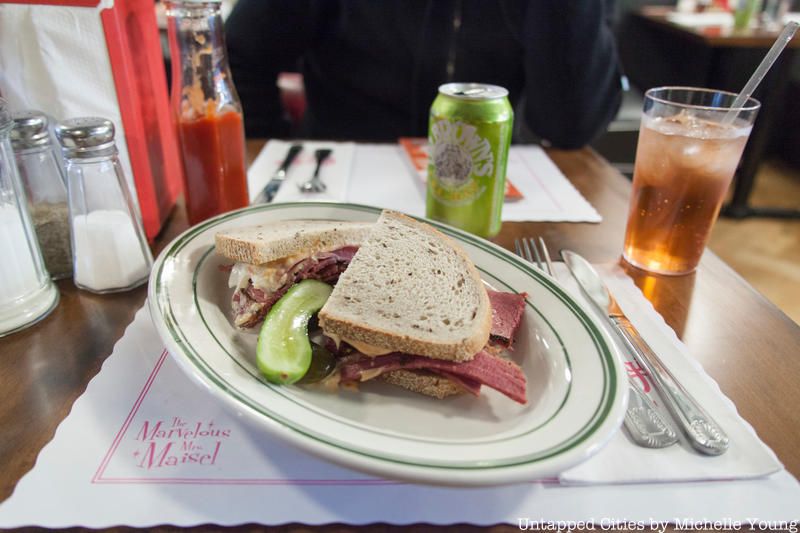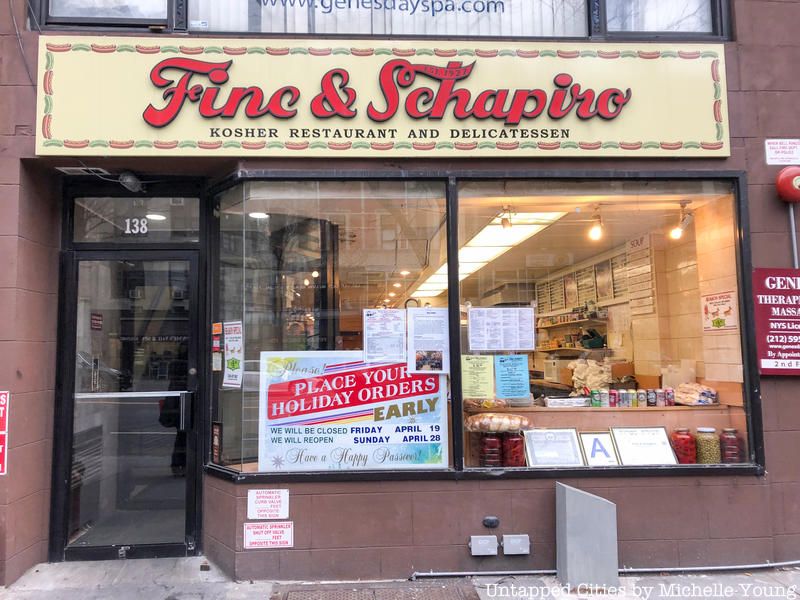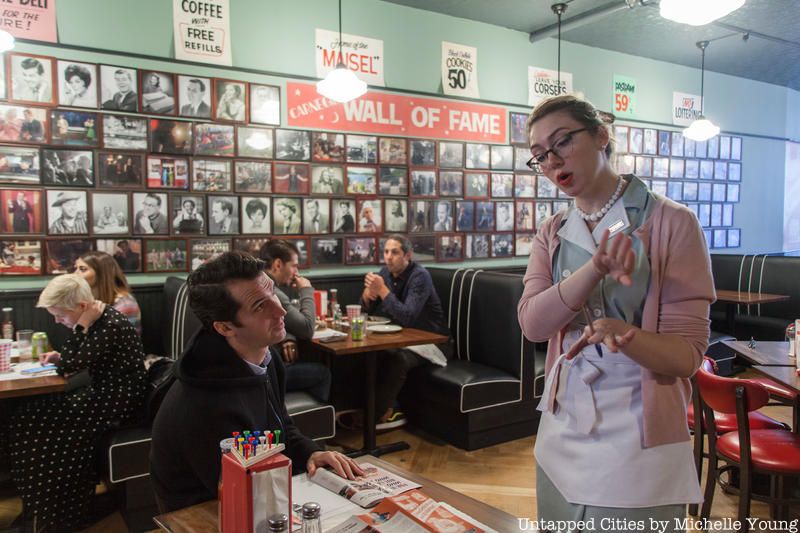Last Chance to Catch NYC's Holiday Notalgia Train
We met the voices of the NYC subway on our nostalgia ride this weekend!


When thinking about iconic New York City eateries, many may point to Peter Luger Steakhouse, Patsy’s Italian Restaurant, or Wo Hop in Chinatown. But chances are, the first that comes to mind is Katz’s Delicatessen, open for (debatably) well over a century serving up classic pastrami on ryes and matzoh ball soups. But Katz’s is one of perhaps two dozen Jewish delis remaining in New York City and the nearby area, and Jewish delis continue to close each year. We take a look at the history of the Jewish deli in New York City, including some lesser-known spots keeping traditions alive.

The birth of the Jewish deli occurred in the late 1800s after waves of German immigrants settled predominantly on the Lower East Side. Many delis were opened by the second generation of immigrant families, while the first generation opened up more traditional delicacy shops or took to other industries to make a living. The deli possibly began as an offshoot of Jewish-German gourmet food stores, which were sometimes called Delikatessens. The first delis that were reminiscent of what we know today drew from the culinary traditions of non-Jewish Germans, who were already serving items like cold cuts, sausages, pickled herring, and dill pickles. Yiddish-speaking Eastern European immigrants pulled from some of these dishes while adding some of their own, including pastrami, a dish native to Romania.
The catch was, nobody really ate like this back in Eastern Europe. Most Jewish families rarely ate out, and many deli items were considered delicacies. Huge sandwiches stuffed high with fatty cured meats and doused with mustard were likely not the common diet of Jews in countries like Romania or Poland. In fact, “delicatessen” derives from the Latin word for “delicate” or “luxurious.” The first Yiddish-run delis were quite like the German ones, except pork and dairy were removed to remain kosher. Because cheap beef was prevalent in New York City, corned beef became a popular dish, made with brisket preserved in brine, and this led to the development of pastrami, smoked and seasoned corned beef. It is likely that the word “pastrami” was coined in the U.S.
The first Jewish deli, according to Ted Merwin in Pastrami on Rye: An Overstuffed History of the Jewish Deli, opened in 1888. Katz’s Delicatessen reportedly opened in 1888, although some food historians have debated this claim. Brothers Morris and Hyman Iceland established a restaurant at the spot around that time, but Willy Katz arrived in 1903, after which the store changed its name to Iceland and Katz. It was not until 1910 that Katz’s Delicatessen was formed. And immigration records from Ellis Island even note that Morris and Hyman came to the U.S. in 1902, with the delicatessen opening shortly thereafter. There are records of a few Jewish delis popping up in the late 1800s, though, and they began popping up across the country in the very early 1900s.

Delis became a part of the Jewish foodscape when they began opening in New York’s Theater District, attracting many leading Jewish and non-Jewish actors and performers. Jews relied on the deli a as social space to avoid antisemitism prevalent in the 1910s and 1920s where they could also immerse themselves in celebrity culture. The Jewish deli shifted more toward a sit-down restaurant during this time, and they achieved great success during the Great Depression; it is estimated that there were about 1,550 Kosher delis across the five boroughs.
Ratner’s was one of the earliest delis in New York City to attain national attention, often regarded as a complement to Katz’s because it did not serve meat. It was founded in 1905 on the Lower East Side and was known for its cheese blintzes, potato pancakes, gefilte fish, and onion rolls. Reuben’s was open for almost 100 years, starting in 1908 at 802 Park Avenue before moving a few more times. The restaurant named sandwiches after celebrities including Frank Sinatra, and Reuben’s even played a small role in the 1919 Black Sox scandal as the meeting place for some of the planning. Lou G. Seigel’s was also a popular spot, opened in 1917 by a Romanian immigrant.

Barney Greengrass, although today more an appetizing store, opened in 1908 in Harlem, specializing in smoked fish including sturgeon and salmon. It was one of the first stores uptown to serve American Jewish fare, and crowds built up over the years, including when the shop moved to its current Upper West Side location in 1929. Lindy’s was one of the most famous delis, opening in 1921 at 1626 Broadway, between 49th and 50th Streets. Eisenberg’s opened in 1929, while many were founded during the Great Depression including Stage Deli in 1937, B&H Dairy in 1938, and Carnegie Deli in 1937. Some lesser-known ones included A. Forman Delicatessen in Borough Park and Grabstein’s Delicatessen & Restaurant in Canarsie.
There were hundreds of others that operated across the five boroughs during their heyday, but most have been lost to time. Only a handful of photos survive of many of these delis, which could be found on almost every block in certain neighborhoods, but many of the delis featured their names and specialty items in bright neon letters.

Jewish delis became increasingly popular as Jews became more secular, and served as meeting places to talk politics, hold community meals, and even meet spouses. World War II took a toll on these delis, some of which lost significant business and faced meat shortages. Though, many delis banded together, supporting one another during tough times (which might be why many delis feature similar features, including furniture, decorations, and architectural layout). Delis continued to fill their counters with whatever dishes they could whip up, and many tried to maintain their Art Deco interiors.
The 1950s and 1960s, though, were two difficult decades for delis in New York City. Many dozens had already closed, although Second Avenue Deli opened in 1954 while 24-hour Sarge’s Delicatessen & Diner opened in 1964. Following World War II, many Jews moved from predominantly Jewish parts of New York City, including Lower Manhattan and the Upper West and East Sides to other cities, bringing with them the deli. The rise of suburbanization limited interactions between Jews and thus made it more difficult for delis to survive.

Additionally, delis faced increased competition from larger markets and even other kosher restaurants, which could make similar foods at cheaper prices. Because kosher meat was (and still is) expensive to buy and prepare, profit margins at delis were quite small, so when clientele dropped, many could not sustain themselves unless they pulled from other cuisines. Because of the grueling work, many delis struggled to find workers to carry on the lineage, although some delis still open today are now in their fourth generation of owners.
Delis continued to close throughout New York City in the 1970s and 1980s, when people became more health-conscious and less willing to try these cholesterol and fat-heavy sandwiches. This, combined with less frequent cultural transmission of Jewish values and cuisine, made the deli somewhat of a relic of the past. Ultimately, immigration slowed to New York City, and the deli struggled to modernize while holding onto recipes of the past, especially amid a rapidly modernizing city. Ben’s Best, Carnegie Deli, and Fine & Schapiro have all closed in the last few years. Throughout the city, there are still some remnants of these lost delis, though most spaces have been completely renovated and reconstructed for new restaurants and businesses.

However, over the past two decades or so, modern Jewish delis have started to open and old ones are being glorified in movies and TV shows like The Marvelous Mrs. Maisel, The Deuce, and Billions. Perhaps the most notable next generation deli is Mile End Delicatessen in Boerum Hill, which opened in 2010 and is styled after the Montreal-style Jewish deli. Pastrami Queen on the Upper East Side opened in 1998 and takes a more traditional approach, while delicatessen and appetizing spot Frankel’s began in 2016. While only about two dozen delis and deli-inspired restaurants are still open in New York City today (and just a handful in each of the country’s major cities), the deli is undergoing a revitalization and a modernization that will keep tradition alive.
Keep exploring Jewish food traditions on our walking tour and tasting through the Lower East Side!
Next, check out the Top 10 Jewish History Sites on the Lower East Side!
Subscribe to our newsletter